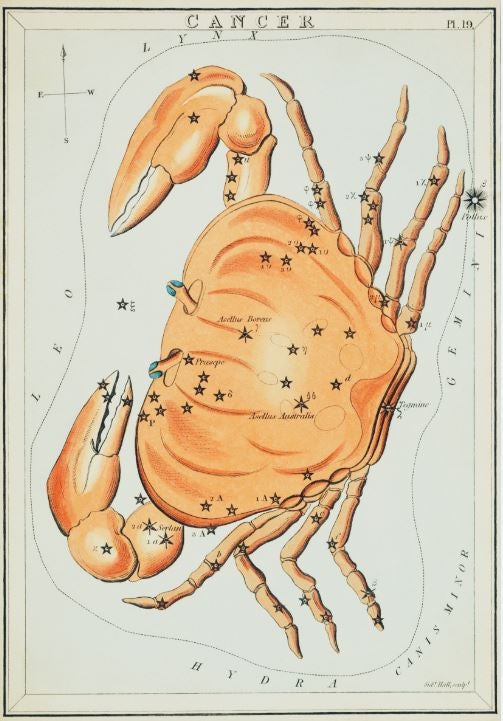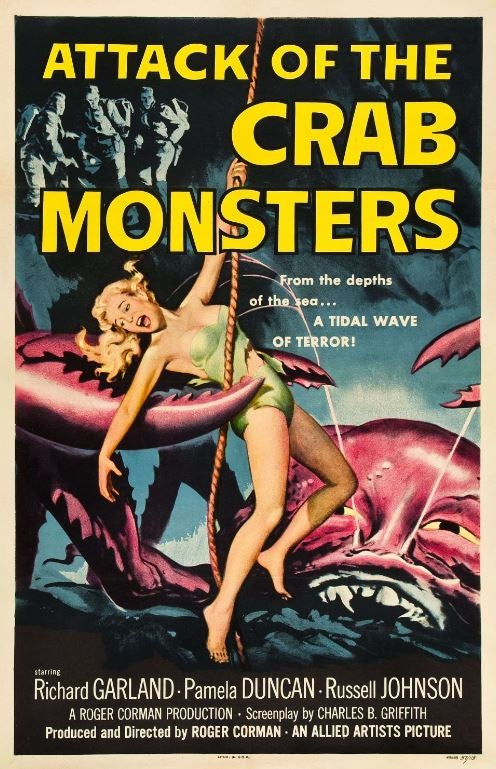The crab appears in myth and metaphor as a grumpy, single-minded and somewhat unpleasant figure. In astrology, those born under the sign of Cancer are said to be moody, broody homebodies. In popular culture, where the crab makes fewer appearances than some creatures we might find more cuddly and more familiar, the crab has some honorable personality traits–loyalty, foremost–but is equally irritating.
If fictional crabs are anything like the species that they are based on, then real-life crabs are nervous, quarrelsome animals. Hence the common use of the term ‘crabby’ to describe someone who is ill tempered, an English-language adjective since the sixteenth century, preceded similarly by ‘crabbed’, dating from thirteenth-century Middle English. William Shakespeare drew on the correlation between bad temper and certain crustaceans in The Two Gentlemen of Verona (c. 1589–93), naming the character Launce’s notoriously disloyal dog ‘Crab’. His master laments: ‘I think Crab, my dog, be the sourest-natured dog that lives.’
Humans are expert at projecting our desires and fears onto each other and onto other beings, and we have a long tradition of developing myth, fable, parable and more from our observations of animal behavior. Maybe those stories reveal kernels of truth here and there. Maybe they are convenient, embellished tales that cast the crab in roles she wasn’t really born to play. As Maryland waterman Grant Corbin told William Warner, author of a classic book about blue crabs called Beautiful Swimmers, ‘nobody knows nothing about crabs . . . Might think they do, but they don’t.’ What is really happening in the mind of a crab? Can the creature be said to have a mind at all? Can we ever know?
In ancient Greek and Roman mythology, the crab is a fierce, devoted soldier, but ultimately vulnerable. In the second of the Twelve Labours of Heracles (or Hercules), Heracles faces the Lernaean Hydra, a multiheaded sea serpent raised by his stepmother and nemesis Hera. Angered that her stepson seems likely to defeat the monster, Hera sends the giant crab Karkinos (Latinized as Carcinus) to aid the hydra. The crab pinches the foot of Heracles, trying to distract him for long enough to give the hydra an advantage. But Heracles kills Karkinos with a blow, cracking his shell, and then slays the hydra. In some versions Heracles propels Karkinos into the sky with a powerful kick; in others Hera places the crab in the heavens in gratitude for his sacrifice–even if it was ultimately ineffectual. Accordingly, Cancer is moderate in size and the least luminous of the zodiacal constellations.

In another celestial myth, Poseidon charges Crios, an immortal giant crab, with the task of guarding his fifty daughters, the sea nymphs. When some of the nymphs steal past Crios, he seeks help from Vamari, the giant squid. Instead of bringing the missing nymphs home, the squid eats those he finds at sea. Crios, realizing he has been tricked, attacks Vamari. While the crab eventually prevails, he is badly wounded. Poseidon honours Crios’ service by relieving him of pain and placing him safely among the stars. The spot he finds in the sky is a modest one, tucked between the much brighter constellations Leo and Gemini.
These mythic crabs are loyal, well-meaning and pugnacious. They are also a little bit bumbling–minor characters–and never stars of the show or the skies. Likewise, in astrology derived from Hellenic tradition, Cancerians (born from about 22 June to 22 July) are said to be, at their best, intuitive, insightful, nurturing and dependable. At their worst, those of us who were born under the sign of Cancer are overprotective, temperamental, sentimental and possessive. Jyotisha, the Vedic system of astrology, also recognizes the crab, Karka, but crustaceans are missing from the Chinese zodiac. At least one humourist insists that Cancer is ‘objectively the worst star sign’, having been saddled with ‘the absolute trifecta of shit characteristics. The star sign shares its name with a terminal illness, it’s visually represented as a crab or 69 or both, and its most readily identifiable characteristic is, like, weepiness’, none of which look good in an online dating profile. Like Karkinos and Crios, Cancerians are faithful to a fault, tough under pressure, but not quite the hero.
We insert ourselves everywhere, making the world more to our liking–and more to our likeness.
Speaking of the use of the term ‘cancer’ for any number of diseases that, broadly speaking, are caused by abnormal cell growth, historians date the use of that term to the Greek physician Hippocrates (c. 460–370 bce). He used the terms karkinos and karkinoma to describe tumors marked by swollen veins, which he likened to the many legs of a crab. At least, this is the version of the origins of the metaphorical name popularized in the medical writings of Galen of Pergamon (129–c. 200–216 ce). Or maybe Hippocrates found tumors hard like the crab’s shell. These explanations draw inspiration from the crab’s appearance, but there are also those who would liken the disease’s pertinacity to the crab’s legendary stubbornness.
In popular culture, crabs are just as tenacious as in ancient myth, often cast as supporting players and rendered so ambiguously that it is difficult to be convinced of their crabness. No crab appears in the original fairy tale The Little Mermaid (1837) by Hans Christian Andersen. Disney’s animated adaptation, released in 1989, created a character named Sebastian the Crab, who doubles as an orchestra leader and as a sidekick to King Triton. Sebastian is charged with responsibility for looking out for the king’s daughter, Ariel, just as Crios was meant to guard Poseidon’s nymphs. Sebastian’s musical influences are Jamaican reggae and Trinidadian calypso, but his crustacean roots are murkier. Lobster-like in some aspects (an elongated shell, a head separate from his thorax, and outsized symmetrical claws), Sebastian is further decarcinized by the anthropomorphic features of his face (googly eyes with white sclera and a tooth-baring grin). More convivial than most crab characters, he does retain some stereotypical traits: he is nervous and irritable.
Another pop-culture crab is just as ambivalently crab-like: Dr John Zoidberg, a character on Futurama, an animated series created by Matt Groening for Fox (1999–2003) and Comedy Central (2008–13), is a ‘Decapodian’, but if he has more than two walking legs and two clawed hands, they must be hidden under his lab coat. Incompetent, unlikeable, grossly omnivorous and offensively smelly, Zoidberg has referred to himself as a crab: in the episode ‘Stench and Stenchability’, upon cutting his own arm with his claw, he cries, ‘Ouch, I forgot I was a giant crab’–but other episodes liken him to a lobster.
In Nickelodeon’s animated television program SpongeBob SquarePants (1999–present), the unmistakably crab-like character Mr Krabs is the greedy owner of a fast-food restaurant. He is prone to outbursts directed at his employees but is also a devoted parent to his daughter, who happens to be a sperm whale. The episode ‘Kracked Krabs’, in which Mr Krabs competes for an award from the League of Cheapskate Crabs, makes clear that miserliness is a trait of the species, not simply the individual. Bright red, like Sebastian, Mr Krabs appears to have only two walking legs (plus large claws, used as hands) when standing still, but in scenes where he walks, a motion blur effect and rapid clicking or chattering sound effects suggest the multiple legs of a crab. At least he has stalked eyes.

Occasionally crabs become, in our fantasies, actual villains. In the Australian Children’s Television Foundation’s 2002 superhero series Legacy of the Silver Shadow, the Crab is a former industrialist hellbent on world domination, grooming his granddaughter Crab Girl to carry on his evildoing, but other than their red costumes, there isn’t much crab to their characters. Just as improbably, crabs embody our worst fears in Roger Corman’s low-budget monster movie Attack of the Crab Monsters (1957). Grown to enormous proportions after exposure to radiation from nuclear weapons testing like that actually conducted on Bikini Atoll by the United States, Corman’s fantastical crabs occupy a small South Pacific island and feed on teams of scientists sent to study the impact of radiation on the area. But they don’t just get nourishment from their prey; they eat their brains, absorb their intelligence and develop the capacity to communicate telepathically with humans. They want to destroy human life, but their ceaseless burrowing threatens to destroy the island they live on; their single-mindedness leads to their downfall.
The crabs I’ve mentioned aren’t the only ones to appear in popular culture. Among the best known is Jimmy, a blue crab in James Michener’s epic novel Chesapeake (1976). In Michener’s florid hands, Jimmy moults and mates in painstaking detail until the 1886 flood that swelled the Susquehanna River dumps a ‘vast cesspool’ of human and industrial waste into the Chesapeake Bay: Jimmy, his mate, and some of the people who eat their kin don’t survive the toxins. (Could it be a coincidence that novelist John Barth, while claiming not yet to have read Michener’s book, quipped that ‘most historical fiction is a pretty fishy rendition of a crab’, not long after its publication?) You might find a crab or two in Lewis Carroll’s Alice’s Adventures in Wonderland (1865) or even in one of the video games based on it, such as the horror-adventure Alice: Madness Returns (2011), where you can encounter the cigar-chomping Cannon Crab. There are annoying little crabs in the Disney/Pixar film Finding Nemo (2003) that hang out on sewer pipes, pester passers-by and don’t really want to help find Nemo. And there are sometimes crabs, in droves, in Disney’s Peter Pan spin-off, the cartoon tv series Jake and the Never Land Pirates (2011–16). King Crab is the bearded, boastful leader of King Crab Island, not far from Never Land. ‘I used to be the prince of pinch. Now . . . I’m the royal claw!’, he sings, living up to expected stereotypes. It is perhaps only the same series’ occasional appearances by Snappy the Hermit Crab that go against the grain: Snappy, who inhabits a pink shell with purple polka dots, is friendly and gentle. (In our imaginations, maybe it is only brachyurans that are crabby.)
There is, despite all these stories to the contrary, one myth in which crabs are honoured heroes who became wartime martyrs: it is said that Heike warriors who died at sea in the Battle of Dan-no-ura in 1185 are reincarnated as Heike-gani, the Heike (formerly Dorippe) japonica. No wonder. The dorsal carapace of the Heike or samurai crab has a set of ridges that happen to recall a grimacing face, outlining eyes, full cheeks and a round mouth. Obviously, the souls of the lost warriors found their way into these oceanic crabs.
Evolutionary biologist Julian Huxley, in an article in Life magazine in 1952, came up with another intriguing explanation for how the Heike came to carry faces on their backs. He suggested that Japanese fishermen, out of respect for the Heike warriors, had long thrown back crabs that most resembled the samurai, and taken only the less humanoid as food. Huxley’s tale is a clever tale of artificial selection, in which humans control animal breeding, as for livestock or domestic animals. If it were true that crabs without samurai-faced shells were removed and therefore unable to reproduce as much as those with samurai-faced shells, then that trait would become more pronounced in future generations. Astronomer Carl Sagan picked up the story in his book Cosmos (1980) and the TV series based on it.
There’s just one problem.
People don’t commonly eat these crabs. There’s no evidence–beyond Huxley’s hypothetical–that fisherman ever sorted and saved any of them. They don’t grow much larger, measured across the carapace, than 2 cm, or maybe an inch. That’s not much meat, and awfully tedious picking to get at it.
Marine biologist Joel Martin dismissed the role of artificial selection in the appearance of faces on the backs of samurai crabs, showing that their grooves and ridges make room for internal organs and musculature. In the end, the desire to see samurai on the back of crabs is nothing more than an instance of pareidolia, a human phenomenon in which our brains strive to make sense of patterns and abstractions and often come up with–surprise–human forms, especially faces. But the desire to explain those faces as a product of our own actions suggests something else at work.
In the Huxley/Sagan myth, Man (I use the gendered term purposefully) is a kind of minor farmer-god engaging in a form of accidental animal husbandry that brought out certain species traits and suppressed others in the crabs. If the Heike myth was, in the end, only speculative and eventually discountable, it nevertheless remains true that humans have tremendous impact on the lives of nonhuman animals. We insert ourselves everywhere, making the world more to our liking–and more to our likeness.
At the same time, we project our own insecurities onto creatures with motives to which we have little access. The notion of ‘crab mentality’ draws on the creature’s observed behaviors to deride human foibles, possibly deriving from a Filipino adage: put one lone crab in a basket and he will figure out how to climb out. A dozen crabs, however, will pull the one that tries to escape back down into the basket. Roughly comparable to the phrase ‘tall poppy syndrome’ used in the United Kingdom, Australia and New Zealand (in fact, many societies use a similar aphorism), ‘crab mentality’ suggests bullying competition and self-defeating resentment. Let’s hope it is only humans, and not some unfortunate crabs, that actually suffer from it.
Reprinted with permission from Crab by Cynthia Chris, published by Reaktion Books Ltd. Copyright © Cynthia Chris 2021. All rights reserved.































